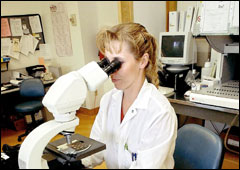Induced pluripotent stem cells (iPS cells) are adult cells that have been reprogrammed back to an embryonic-like (pluripotent) state without creating or destroying embryos.
Prolifers have been pointing to iPS cells since they were created as an alternative to destroying embryos for embryonic stem cells. Unlike embryonic stem cells that come from an embryo that is genetically different, iPS cells would be better for transplant because they would already be a genetic match to the patient. iPS cells are also an alternative to cloning embryos for stem cells. The only reason to clone an embryo to harvest stem cells would be to get embryonic stem cells that are a genetic match to the patient. iPS technology achieves the same result as cloning without any eggs and without cloning and destroying human embryos.
 First the good news on iPS cells. Researchers at Johns Hopkins have found that iPS derived liver cells behave just as well as liver cells derived from embryonic stem cells and other adult stem cells in a mouse model. From Genetic Engineering and Biotechnology News:
First the good news on iPS cells. Researchers at Johns Hopkins have found that iPS derived liver cells behave just as well as liver cells derived from embryonic stem cells and other adult stem cells in a mouse model. From Genetic Engineering and Biotechnology News:
Researchers have demonstrated that mature and immature liver cells generated from induced pluripotent stem cells (iPSCs) derived from multiple adult cell types are as effective as both embryonic stem cell (ESC)-derived hepatocytes and primary human hepatocytes at engrafting and functioning in the livers of experimental mice. The Johns Hopkins University School of Medicine team that carried out the studies say iPSC-derived cells were equivalent to the ESC-derived cells and primary hepatocytes in terms of their capacity to regenerate damaged livers and with respect to the levels of human-specific liver proteins they secreted into the animals’ bloodstreams.
But another study has some bad news. IPS cells are created by reprogramming an adult cell back to an embryonic state. Researchers at UC San Diego have found that the reprogramming of the cells caused rejection in the immune system of the mice they studied even though the iPS cells were genetically identical. From the New York Times:
In an unexpected setback to efforts to harness a promising new type of stem cell to treat diseases, researchers reported on Friday that tissues made from those stem cells might be rejected by a patient’s immune system — even though the tissues would be derived from that very same patient.
The research involved so-called induced pluripotent stem cells, or iPS cells, which can be made from skin cells and which appear to have the characteristics of embryonic stem cells. That means they can theoretically be turned into nerve, heart, liver or other types of cells and transplanted to repair damaged organs.
The initial creation of human iPS cells in 2007 electrified scientists because the cells seemed to have two big advantages over embryonic stem cells. They were not controversial, because their creation did not entail the destruction of human embryos. And since the stem cells could be made from a particular patient’s skin cells, they could be used to make tissues that presumably would not be rejected by that patient’s immune system.
But that latter assumption was never really tested, until now. When Yang Xu, a biologist at the University of California, San Diego, and colleagues did so, they found that iPS cells made from mouse skin cells were nonetheless rejected by genetically identical mice.
Of course the BAD news about iPS cells made the New York Times and the GOOD news was left to the technical media outlet that has less readers. That observation aside, this is not great news not because the iPS cells were rejected so much as it will be a rallying cry for those who want to continue destroying existing IVF embryos for stem cells and for those who want to clone and destroy new embryos. They will argue that this rejection problem is a reason to push embryo destructive avenues again.
This is a ridiculous notion. If genetically identical stem cells were rejected just because of some reprogramming, certainly embryonic stem cells from a totally different organism will also be rejected and even more so. Robert Lanza, cloner extraordinaire, from Advanced Cell Technology is already saying that this opens the need for SCNT or cloning again. This is also nonsense because SCNT does not really create genetically identical embryos. Because SCNT uses eggs, there is DNA leftover from the woman who donated the eggs. And if genetically identical iPS cells were rejected just because of some reprogramming, certainly cloned embryonic stem cells that have DNA leftover from the woman who supplied the egg will have a greater chance of being rejected as well.
LifeNews.com Note: Rebecca Taylor is a clinical laboratory specialist in molecular biology, and a practicing pro-life Catholic who writes at the bioethics blog Mary Meets Dolly. She has been writing and speaking about Catholicism and biotechnology for five years and has been interviewed on EWTN radio on topics from stem cell research and cloning to voting pro-life. Taylor has a B.S. in Biochemistry from University of San Francisco with a national
certification in clinical Molecular Biology MB (ASCP).







